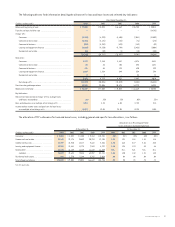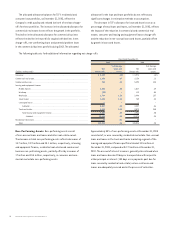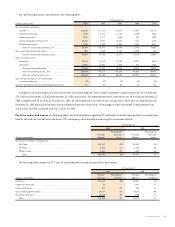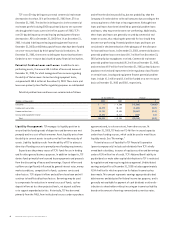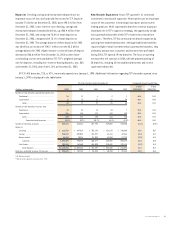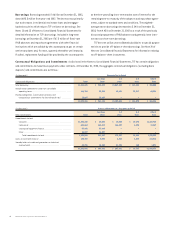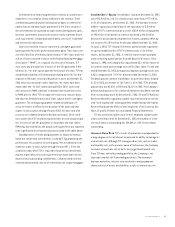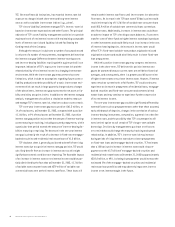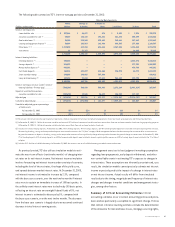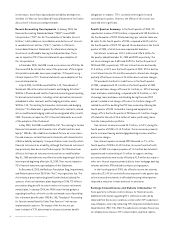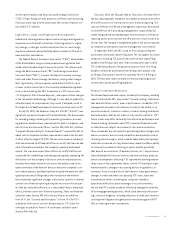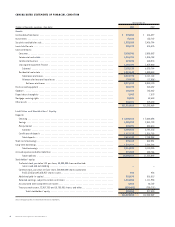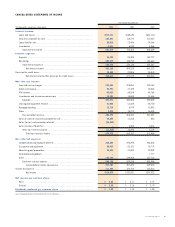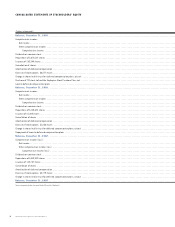TCF Bank 2003 Annual Report Download - page 49
Download and view the complete annual report
Please find page 49 of the 2003 TCF Bank annual report below. You can navigate through the pages in the report by either clicking on the pages listed below, or by using the keyword search tool below to find specific information within the annual report.
2003 Annual Report 47
investor presentations and Securities and Exchange Commission
(“SEC”) filings. Replays of prior quarterly conference calls discussing
financial results may also be accessed at the investor relations sec-
tion within TCF’s website.
Legislative, Legal and Regulatory Developments
Federal and state legislation imposes numerous legal and regulatory
requirements on financial institutions. Future legislative or regula-
tory change, or changes in enforcement practices or court rulings,
may have a dramatic and potentially adverse impact on TCF and its
bank and other subsidiaries.
The Federal Deposit Insurance Corporation (“FDIC”) and members
of the United States Congress have proposed new legislation that
would reform the bank deposit insurance system. This reform could
merge the Bank Insurance Fund (“BIF”) and Savings Association
Insurance Fund (“SAIF”), increase the deposit insurance coverage
limits and index future coverage limitations, among other changes.
Most significantly, reform proposals could allow the FDIC to raise
or lower (within certain limits) the currently mandated designated
reserve ratio requiring the FDIC to maintain a 1.31% reserve ratio
($1.31 against $100 of insured deposits), and require certain changes
in the calculation methodology. Although it is too early to predict the
ultimate impact of such proposals, they could, if adopted, result in
the imposition of additional deposit insurance premium costs on TCF.
On July 30, 2002, the Sarbanes-Oxley Act of 2002 (“the Act”) was
signed into law by the President of the United States. The Act provides
for sweeping changes dealing with corporate governance, account-
ing practices and disclosure requirements for public companies, and
also for their directors and officers. Section 302 of the Act, entitled
“Corporate Responsibility for Financial Reports,” required the SEC to
adopt rules to implement certain requirements noted in the Act and
it did so effective August 29, 2002. The new rules require a company’s
chief executive and chief financial officers to certify the financial and
other information included in the company’s quarterly and annual
reports. The rules also require these officers to certify that they are
responsible for establishing, maintaining and regularly evaluating the
effectiveness of the company’s disclosure controls and procedures;
that they have made certain disclosures to the auditors and to the
audit committee of the board of directors about the company’s con-
trols and procedures; and that they have included information in their
quarterly and annual filings about their evaluation and whether
there have been significant changes in disclosure controls or internal
controls over financial reporting during the most recent fiscal quar-
ter that has materially affected, or is reasonably likely to materially
affect, internal control over financial reporting. These certifications
called for under Section 302 of the Act are filed as an exhibit to
Form 10-K. See “Controls and Procedures” in Form 10-K for TCF’s
evaluation of disclosure controls and procedures. TCF is also fur-
nishing as an exhibit to Form 10-K certificates called for under
Section 906 of the Act.
On June 5, 2003, the SEC published its final rules on Section 404 of
the Act, requiring public companies to complete an annual assessment
of the effectiveness of internal control over financial reporting. The
rules are effective in 2004 and a management report must be included
in the 2004 Form 10-K describing management’s responsibility for
establishing and maintaining adequate internal control over financial
reporting and its assessment of the effectiveness of such controls as
of year-end. The Company’s independent auditors will also be required
to complete an attestation report on management’s assessment.
In September 2002, the SEC issued its final ruling covering the
acceleration of periodic report filing dates. The rule applies to certain
companies, including TCF, and will reduce the annual report filing
deadline from 90 days after year-end to 60 days after year-end for
TCF’s 2004 Annual Report. The quarterly report on Form 10-Q filing
deadline will also be accelerated from 45 days after quarter-end
to 35 days after quarter-end for the quarterly Form 10-Q filings in
2005. TCF has taken steps to modify its financial reporting process
to meet these accelerated filing deadlines.
Forward-Looking Information
This Annual Report and other reports issued by the Company, including
reports filed with the SEC, may contain “forward-looking” statements
that deal with future results, plans or performance. In addition, TCF’s
management may make such statements orally to the media, or to
securities analysts, investors or others. Forward-looking statements
deal with matters that do not relate strictly to historical facts. TCF’s
future results may differ materially from historical performance and
forward-looking statements about TCF’s expected financial results
or other plans are subject to a number of risks and uncertainties.
These include but are not limited to possible legislative changes and
adverse economic, business and competitive developments such as
shrinking interest margins, which could be impacted by lower prepay-
ment rates in a period of rising interest rates; deposit outflows; ability
to increase the number of checking accounts and the possibility
that deposit account losses (fraudulent checks, etc.) may increase;
reduced demand for financial services and loan and lease products;
adverse developments affecting TCF’s supermarket banking relation-
ships or any of the supermarket chains in which TCF maintains super-
market branches; changes in accounting policies or guidelines, or
monetary, fiscal or tax policies of the federal or state governments;
changes in credit and other risks posed by TCF’s loan, lease and
investment portfolios; technological, computer-related or
operational difficulties; adverse changes in securities markets;
the risk that TCF could be unable to effectively manage the volatility
of its mortgage banking business, which could adversely affect earn-
ings; results of litigation, including reductions in debit card revenues
resulting from litigation brought by retail merchants against VISA®
USA, or other significant uncertainties.


